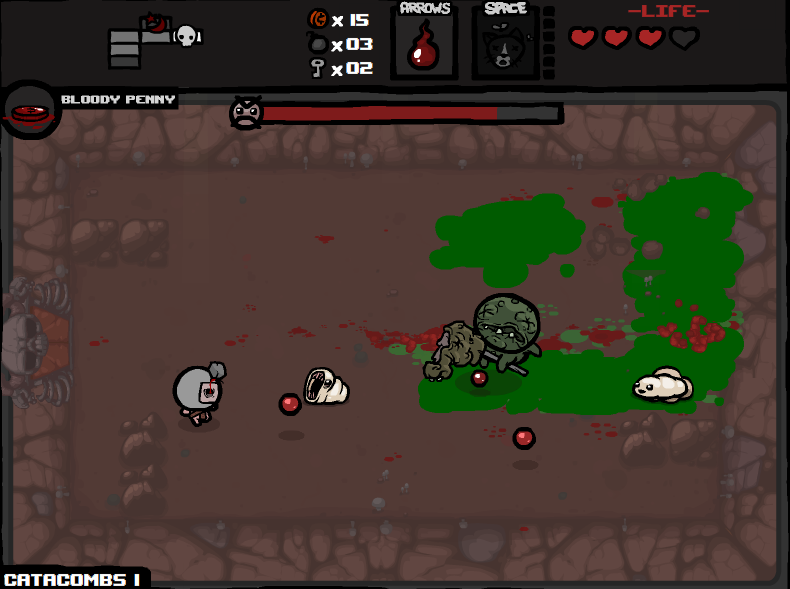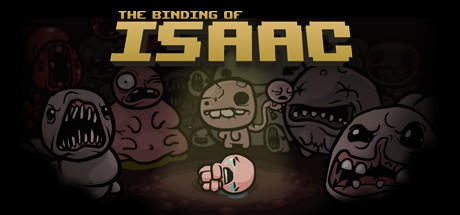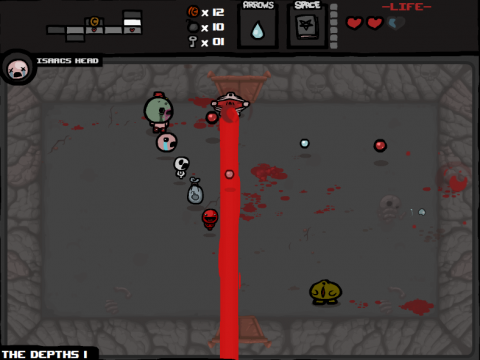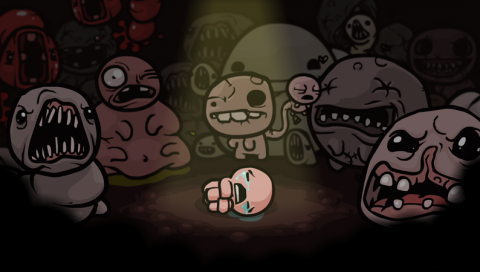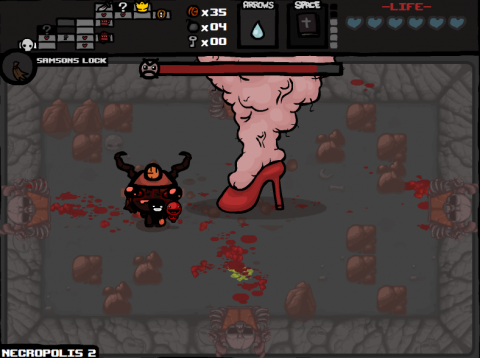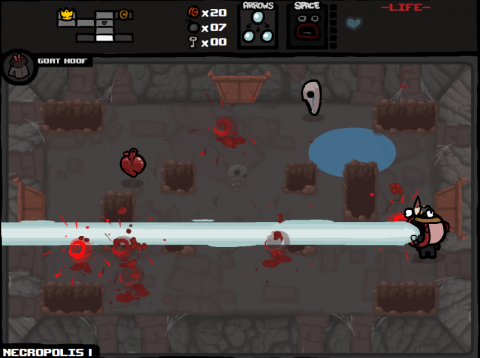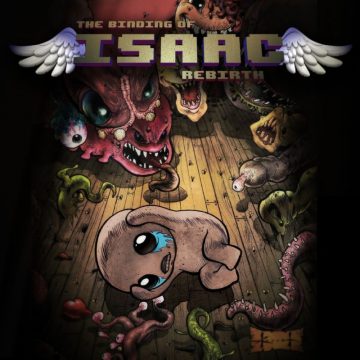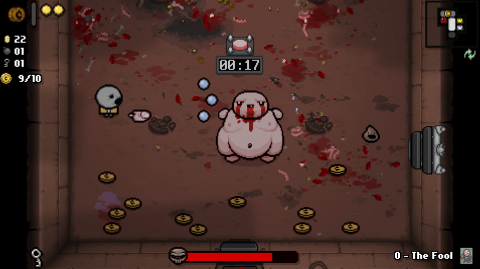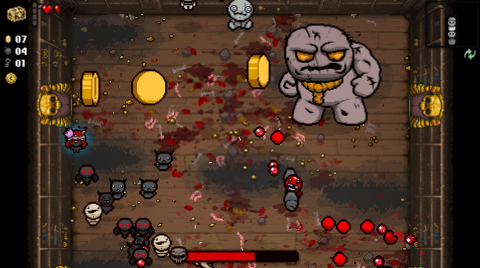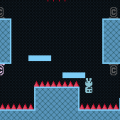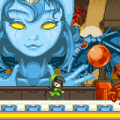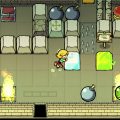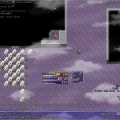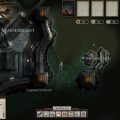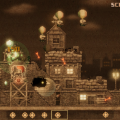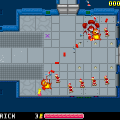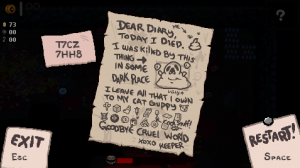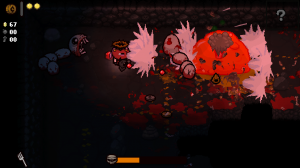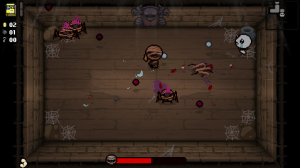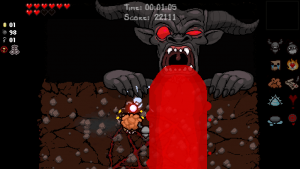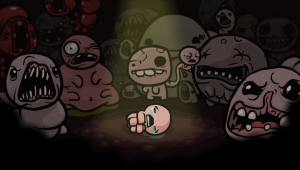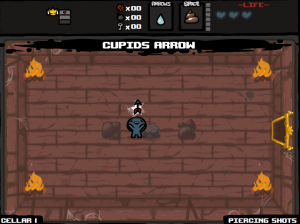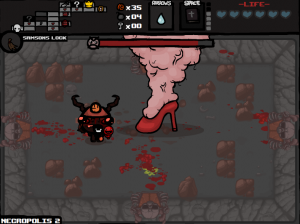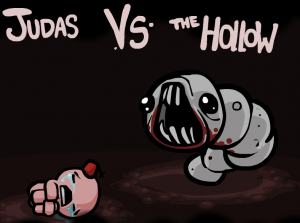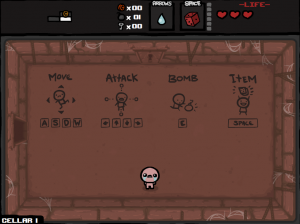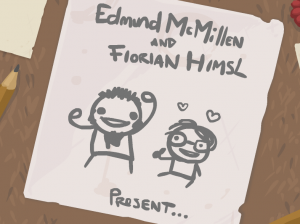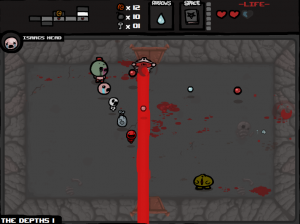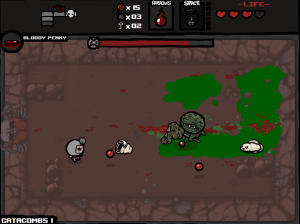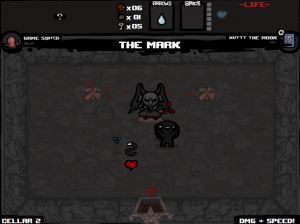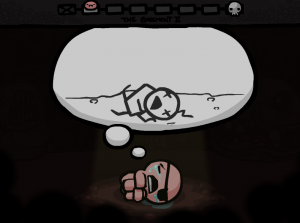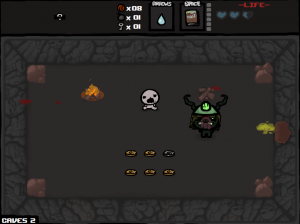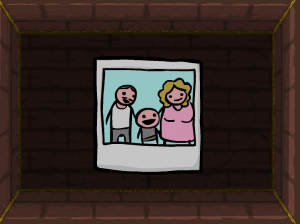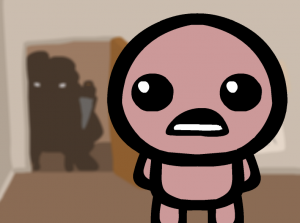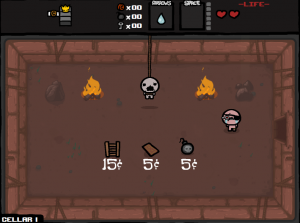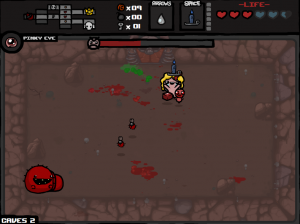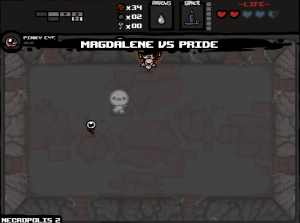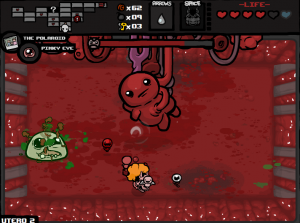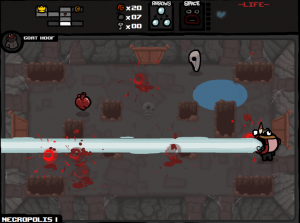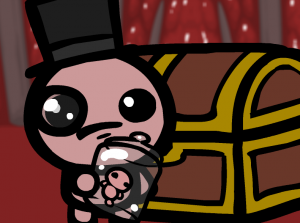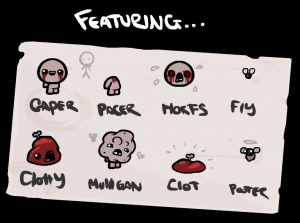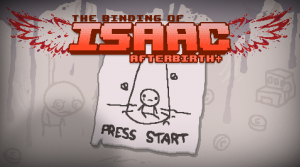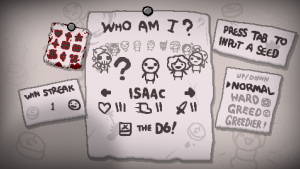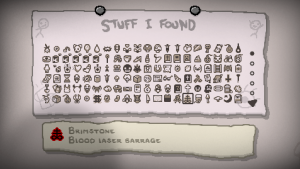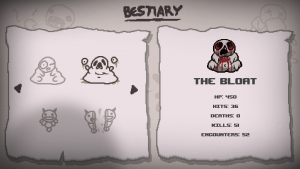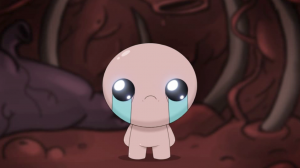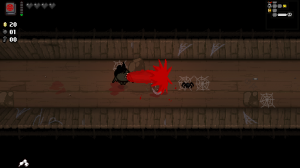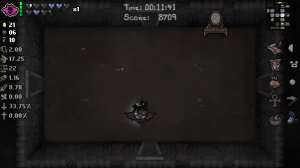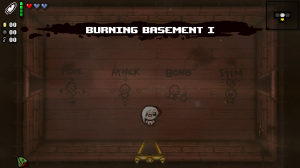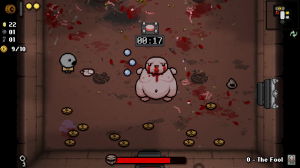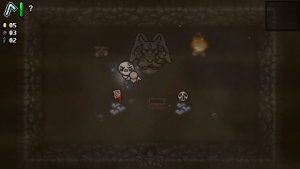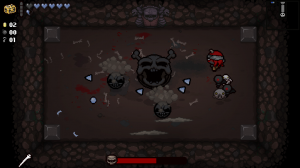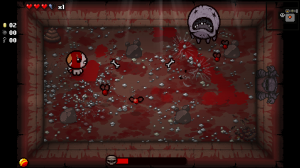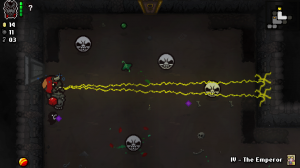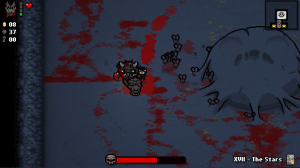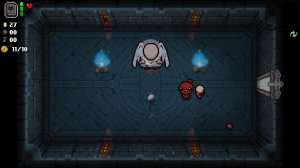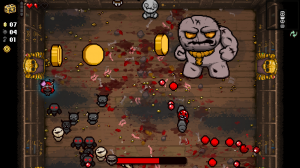Edmund McMillen is arguably the quintessential indie developer. He began his career in 2001, releasing crude games on Newgrounds laden with toilet humor and dead baby comedy – out of the first fifteen games he released, ten of them literally had the words ‘dead baby’ in the title. Irreverent and undeniably talented, he quickly made a name for himself with several titles that still attract attention today; Gish, Triachnid, Coil, Aether, and a small game named Meat Boy that quickly turned into the much larger project, Super Meat Boy, put together by Edmund and Tommy Refenes, which remains one of the most critically and commercially successful indie games to date.
With the financial success of Super Meat Boy, Edmund was free to spend time on more risky ventures that he didn’t expect to get as much attention, but would be more personally fulfilling. Teaming up with Florian Himsl, a programmer who had previously worked with Edmund on Triachnid and Coil, and later Danny Baranowsky, who had composed the music to Super Meat Boy, Edmund focused on what had started as a week-long game jam project with Florian; a roguelike featuring procedurally generated dungeons inspired by The Legend of Zelda. For the name, he chose a story from the bible which represented the mixed feelings he had about his own religious upbringing; the Binding of Isaac.
The Binding of Isaac – the bible story, not the game – takes place in Chapter 22 of Genesis, in which God commands Abraham to sacrifice his only son, Isaac, for no stated reason. Abraham obeys and takes an unknowing Isaac on a trip up a mountain, where he constructs an altar, binds his son, and prepares to kill him. An angel of the Lord intervenes to tell Abraham that now that he has proven that he fears God, he no longer needs to commit the foul deed and asks Abraham to sacrifice a nearby ram instead. I would be extremely unqualified to go into more detail about the many varying interpretations of this story, but the one that resonated with Edmund McMillen was this; at some point, your parents may hear a voice commanding them to murder you for no reason, which they may well obey.
This is far from the only excerpt from the Bible that inspires such fear – we’re not even getting into the Book of Job – but it was this kind of story, combined with the experience of being brought up in a family that was split between traditional Catholics and born-again Christians, that both inspired and disturbed Edmund. In an interview with Gamasutra in 2012, he talked about being intrigued by his grandma’s ritualistic behaviors; lighting candles, praying for loved ones long gone, and claiming to eat the body/drink the blood of her savior. Other members of his family would tell him he was going to hell for playing Dungeons & Dragons and Magic: The Gathering. So all in all, religion had something of a mixed influence on Edmund, and in The Binding of Isaac, he set out to, in his own words, “show the positive and negative effects it had on me as a child – the self-hate and isolation it instilled in me, but also the dark creativity it inspired.”
Edmund’s version of the story involves a child named Isaac, happily living with his mother, who hears a voice from above one day, demanding that she correct her son, who has become corrupted by sin. First she removes his toys and possessions, then locks him in his room for good measure, but the voice demands Isaac as a sacrifice and his mother obeys. As Isaac searches his room for an exit, he spots a trapdoor to the basement, pulls it open, and jumps down just as his mother bursts through the door. And now, we finally reach the gameplay of The Binding of Isaac.
At first glance, you’d be forgiven for thinking that this really was nothing more than a Zelda homage; from the map-display to Isaac’s health being shown in big red hearts reminiscent of Heart Containers, and the three items he can pick up being keys, for access to shops, treasure rooms and locked chests, bombs, for finding secret rooms and damaging enemies, and coins, to be spent at the shop. The stats that you’ll need to pay attention to are also fairly straightforward, for the most part. Isaac’s HP, Speed and Attack Power are rather self-explanatory, but then there’s Tears, Range and Shot Speed. You see, Isaac doesn’t have a sword and shield, but in keeping with the rather horrific circumstances he finds himself in, he defeats his enemies by crying projectile tears at them. The Tears stat refers to the rate at which you fire them, and it quickly becomes clear how vital this is.
Every floor has a Treasure Room, a Shop, and a Boss room, which can reward you with powerful items in exchange for keys, coins, and defeating the Boss. If you go a few floors without getting hit (or the game is feeling particularly generous) you’ll get the opportunity for a post-boss Devil Deal, in which Satan will offer you more powerful items, with the caveat that the only currency he accepts is your health, so you will permanently be ridding yourself of a Heart Container or two in exchange for survivability. But it’s never so difficult to amass HP that you’ll feel as if you can’t risk taking an item, even if you know that you know you probably shouldn’t.
The Binding of Isaac also features several other characters with their own gameplay quirks, such as Cain, who starts with less health but higher speed and attack, Eve, whose passive item ‘Whore of Babylon’ increases her stats dramatically as long as she remains at low health, and Magdalene, a slower and weaker character with more health. Another character, Samson, was added in the May 2012 DLC expansion ‘Wrath of the Lamb’ which also included more items, more bosses, and alternate versions of existing floors. And, in keeping with Edmund McMillen’s roots on Newgrounds, one character, mysteriously named ‘???’ is simply a dead baby.
Items in the game can either be passive or active. A passive item provides a permanent upgrade to one of your stats, or applies a one-time effect on you that will last for the rest of the run. Active items, or Spacebar items as they’re also known, are held by Isaac and can be activated in any room, although most of them have recharge times that vary from item to item. These can turn Isaac temporarily invincible, regenerate health, deal damage to every enemy in the room, or several other effects, some minor, some major.
A lot of the items in the game simply increase and reduce your stats, which is useful, if not particularly interesting. Some items raise all of your stats by a small amount, others reduce one stat at the expense of another, such as the Bucket of Lard, which gives you two HP at the expense of lowering your speed, or Polyphemus, which reduces the rate at which you fire tears, but increases their size and damage. But none of this is why The Binding of Isaac became famous. The items that really grabbed people’s attention were a little… stranger.
If you run into an item that looks a little bit like a Magnemite from Pokémon, that would be Technology, which replaces your tears with shiny red lasers. Technology 2 replaces your tears with a single laser, which is weaker than the former but hits constantly. Combine this with Spoon Bender, which permanently grants you homing tears, and you now have a constant method of attacking all enemies in a room while barely moving. Now add one of the six items in the game that grants you flight and you have transformed from a sobbing child to a flying demon blasting homing lasers from your eyes.
That’s an unlikely combination though, so let’s imagine something else. Brimstone, a popular Devil Deal item, replaces your tears with a chargeable beam of blood that destroys enemies and bosses alike. Mom’s Knife gives you a short-range knife that can be charged up and thrown like a boomerang, which does a criminal amount of damage to every enemy in the game, and also functions as a melee weapon. Dr. Fetus replaces your tears with a never-ending supply of bombs – Epic Fetus replaces them with an airstrike – add in Bobby-Bomb (all bombs home in on enemies) or Bob’s Curse (bombs now poison enemies) for more fun. Add Mutant Spider or Inner Eye, which give you a quadruple shot and triple shot respectively, and you’re now firing four bombs/missiles/knives/lasers/beams of blood at once.
But it’s not like these combinations actually make it impossible for you to lose; no matter what, you can still walk into a difficult room and take a hit. But if you have an item that allows you to regenerate health (Yum Heart or Book of Revelations) and you’ve bought the Nun’s Habit from the shop, which recharges your held item if you ever take damage, then congratulations, you are now officially unkillable. And what makes The Binding of Isaac so great is that these aren’t bugs or glitches that Edmund overlooked, but combinations that he knew existed, and his response was “Ha ha, that’s awesome, let’s keep that in.”
Unfortunately, the reverse can also happen, and truth be told, that is one of the game’s biggest flaws; if you play it for a long enough time, you’re bound to come across a run sooner or later that just plain sucks, and whether you end up annoyed at yourself for losing or annoyed at the game for never giving you a proper chance to succeed, it’s still not a great experience. But without the possibility of terrible runs, you wouldn’t have the joy of stumbling into the most overpowered and unbeatable item combinations, which are not as rare as you might think.
The Binding of Isaac steadily gained a fanbase on YouTube that led to it becoming a huge sleeper hit; people loved playing and replaying the game, sharing their runs and the crazy, stupid, nonsensical, invincible and sometimes self-destructive combinations they encountered. It was so successful that Edmund wanted to add even more content to the game, but unfortunately, as an Adobe Flash project, there was a limit to how much could be added. If he wanted to continue to expand the game, he would have to rebuild it again on another engine. And so, after teaming up with Nicalis – themselves no stranger to rebuilding indie games, having worked on console ports of Cave Story and VVVVVV – The Binding of Isaac: Rebirth was released in November 2014.
The biggest immediate flaw in Rebirth is that once you’ve played it, you will never want to play the original again. The original is a fine game for sure, but Rebirth is faster, smoother, more polished, and contains overwhelmingly more content. The only real downside is the change in soundtrack. As it stands now, with two expansion packs of its own (Afterbirth and Afterbirth+) the updated rerelease has 15 playable characters, 192 enemies, not including the almost 100 bosses, 35 challenge runs, 21 endings, endless randomly generated Daily Runs with online leaderboards, three separate save files, and more than 500 items. And even this doesn’t adequately describe just how much more there is to see in Rebirth.
A Boss Rush if you can make it through the first six floors within twenty minutes, a bullet hell boss fought in a 2×2 size room that for the first time in the series employs damage-scaling, and more game-breaking item combinations than ever before. From immunity to explosive damage, to an item that grants you total invulnerability if you stand still for three seconds, to power-ups that turn your tears into sticky-bombs, electricity, boogers, explosions, nails, beams of light, laser rings, coins, miniature scythes, eyeballs, needles, acid, bug eggs, bones, magnetic tears, transcendent tears, orbiting tears, tears that fire more tears… the list could go on, without ever repeating one of the many items that turns Isaac into a nigh-unstoppable entity of pure destruction.
For owners of the original game, Florian Himsl released – for free – an ‘Eternal Edition’ update in 2015 that included some of the new items from Rebirth, a new hard mode, and various tweaks and bug fixes, but since release, Rebirth has always been known as the most complete experience, even including a community-driven quest to unlock one of the game’s most secret characters, fittingly named ‘The Lost’, who could only be unlocked by killing yourself in consecutive runs as specific characters dying to specific enemies, the order of which was revealed by jigsaw pieces that would appear on Isaac’s will – which appears whenever you lose a run – if you were holding a specific trinket that served no other defined purpose. Unfortunately, dataminers skipped all of that and found the solution quickly, to Edmund’s disappointment. So when the first DLC – Afterbirth – was released, he was much more thorough, including a bizarrely thorough Alternate Reality Game (a series of puzzles that fans had to solve in real life to unlock content within the game) that included ASCII conversions, a missing poster of Isaac found on the Santa Cruz boardwalk, telephone numbers that led to creepy, partially-reversed voicemails, and GPS co-ordinates that eventually led to a group of very dedicated fans bringing their shovels to a remote building in Santa Ana, California, where they unearthed a statue of the latest character, Keeper, who was shortly patched into the game. Edmund McMillen does not do things by halves.
And that’s part of why The Binding of Isaac is such a successful indie game; it couldn’t exist as anything but an indie game. Could you imagine Ubisoft or Konami releasing a game like this; a game in which it’s possible to stumble into a situation where you are literally unable to lose, a game with so many enemies, bosses and power-ups that evoke strong religious imagery, but also dead baby and fart jokes, a game where it’s possible to fight angels, Satan, your mother, and several sentient piles of poop? This game would have been nerfed and balanced and altered, appropriately enough, to hell and back, but while Edmund isn’t averse to making changes where necessary, he always does so based on how much fun the experience could be. The Binding of Isaac is a perfect representation of the indie mentality of making fun the highest priority and working backwards from there.
The Binding of Isaac is a beautiful example of artistic freedom and creativity and the weird and mostly wonderful things that can happen when it’s encouraged rather than stifled. Edmund still isn’t finished with the game, and while we all may let out a groan of “Well, there goes my weekend!” every time even more content has been added, there’s a reason why, almost eight years after its release, so many of us are still checking.
